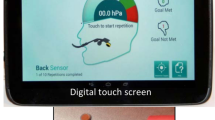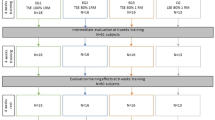Abstract
The objective of this study was to compare the outcomes of two tongue resistance training protocols. One protocol (“tongue-pressure profile training”) emphasized the pressure-timing patterns that are typically seen in healthy swallows by focusing on gradual pressure release and saliva swallowing tasks. The second protocol (“tongue-pressure strength and accuracy training”) emphasized strength and accuracy in tongue-palate pressure generation and did not include swallowing tasks. A prospective, randomized, parallel allocation trial was conducted. Of 26 participants who were screened for eligibility, 14 received up to 24 sessions of treatment. Outcome measures of posterior tongue strength, oral bolus control, penetration–aspiration and vallecular residue were made based on videofluoroscopy analysis by blinded raters. Complete data were available for 11 participants. Significant improvements were seen in tongue strength and post-swallow vallecular residue with thin liquids, regardless of treatment condition. Stage transition duration (a measure of the duration of the bolus presence in the pharynx prior to swallow initiation, which had been chosen to capture impairments in oral bolus control) showed no significant differences. Similarly, significant improvements were not seen in median scores on the penetration–aspiration scale. This trial suggests that tongue strength can be improved with resistance training for individuals with tongue weakness following stroke. We conclude that improved penetration–aspiration does not necessarily accompany improvements in tongue strength; however, tongue-pressure resistance training does appear to be effective for reducing thin liquid vallecular residue.




Similar content being viewed by others
References
Martino R, Foley N, Bhogal S, Diamant N, Speechley M, Teasell R. Dysphagia after stroke: incidence, diagnosis, and pulmonary complications. Stroke. 2005;36:2756–63.
Martino R, Martin RE, Black S. Dysphagia after stroke and its management. CMAJ. 2012;184:1127–8.
Clavé P, Rofes L, Arreola V, Almirall J, Cabré M, Campins L, García-Peris P, Speyer R. Diagnosis and management of oropharyngeal dysphagia and its nutritional and respiratory complications in the elderly. Gastroenterol Res Pract. 2011;. doi:10.1155/2011/818979.
Robbins J, Gensler G, Hind J, Logemann JA, Lindblad AS, Brandt D, Baum H, Lilienfeld D, Kosek S, Lundy D, Dikeman K, Kazandian M, Gramigna GD, McGarvey-Toler S, Miller Gardner PJ. Comparison of 2 interventions for liquid aspiration on pneumonia incidence: A randomized trial. Ann Intern Med. 2008;148:509–18.
Robbins J, Nicosia MA, Hind JA, Gill GD, Blanco R, Logemann JA. Defining physical properties of fluids for dysphagia evaluation and treatment. Perspectives on swallowing and swallowing disorders (Dysphagia). American Speech-Language Hearing Association Special Interest Division 13 Newsletter 2002, pp 16–19.
Steele CM, Alsanei WA, Ayanikalath S, Barbon CE, Chen J, Cichero JA, Coutts K, Dantas RO, Duivestein J, Giosa L, Hanson B, Lam P, Lecko C, Leigh C, Nagy A, Namasivayam AM, Nascimento WV, Odendaal I, Smith CH, Wang H. The influence of food texture and liquid consistency modification on swallowing physiology and function: a systematic review. Dysphagia. 2015;30:2–26.
Burkhead LM, Sapienza CM, Rosenbek JC. Strength-training exercise in dysphagia rehabilitation: principles, procedures, and directions for future research. Dysphagia. 2007;22:251–65.
Pouderoux P, Kahrilas PJ. Deglutitive tongue force modulation by volition, volume, and viscosity in humans. Gastroenterology. 1995;108:1418–26.
Stierwalt JA, Youmans SR. Tongue measures in individuals with normal and impaired swallowing. Am J Speech Lang Pathol. 2007;16:148–56.
Youmans SR, Youmans GL, Stierwalt JA. Differences in tongue strength across age and gender: is there a diminished strength reserve? Dysphagia. 2009;24:57–65.
Nicosia MA, Hind JA, Roecker EB, Carnes M, Doyle J, Dengel GA, Robbins J. Age effects on the temporal evolution of isometric and swallowing pressure. J Gerontol Ser A. 2000;55:M634–40.
Fei T, Polacco RC, Hori SE, Molfenter SM, Peladeau-Pigeon M, Tsang C, Steele CM. Age-related differences in tongue-palate pressures for strength and swallowing tasks. Dysphagia. 2013;28(4):575–81.
Utanohara Y, Hayashi R, Yoshikawa M, Yoshida M, Tsuga K, Akagawa Y. Standard values of maximum tongue pressure taken using newly developed disposable tongue pressure measurement device. Dysphagia. 2008;23:286–90.
Vanderwegen J, Guns C, Van Nuffelen G, Elen R, De Bodt M. The influence of age, sex, bulb position, visual feedback, and the order of testing on maximum anterior and posterior tongue strength and endurance in healthy belgian adults. Dysphagia. 2013;28:159–66.
Butler SG, Stuart A, Leng X, Rees C, Williamson J, Kritchevsky SB. The association between aspiration status and tongue and handgrip strength in healthy older adults. J Am Geriatr Soc. 2010;58:S132.
Steele CM, Cichero JA. Physiological factors related to aspiration risk: a systematic review. Dysphagia. 2014;29:295–304.
Robbins J, Gangnon RE, Theis SM, Kays SA, Hewitt AL, Hind JA. The effects of lingual exercise on swallowing in older adults. J Am Geriatr Soc. 2005;53:1483–9.
Robbins J, Kays SA, Gangnon RE, Hind JA, Hewitt AL, Gentry LR, Taylor AJ. The effects of lingual exercise in stroke patients with dysphagia. Arch Phys Med Rehabil. 2007;88:150–8.
Steele CM. Optimal approaches to measuring tongue-pressure functional reserve. J Aging Res. 2013. Article ID 542909. doi:10.1155/2013/542909
Winstein CJ, Rose DK, Tan SM, Lewthwaite R, Chui HC, Azen SP. A randomized controlled comparison of upper-extremity rehabilitation strategies in acute stroke: a pilot study of immediate and long-term outcomes. Arch Phys Med Rehabil. 2004;85:620–8.
Monfils M-H, Teskey GC. Skilled-learning-induced potentiation in rat sensorimotor cortex: a transient form of behavioural long-term potentiation. Neuroscience. 2004;125:329–36.
Yeates EM, Molfenter SM, Steele CM. Improvements in tongue strength and pressure-generation precision following a tongue-pressure training protocol in older individuals with dysphagia: three case reports. Clin Interv Aging. 2008;3:735–47.
Steele CM, Bailey GL, Polacco RE, Hori SF, Molfenter SM, Oshalla M. Outcomes of tongue-pressure strength and accuracy training for dysphagia following acquired brain injury. Int J Speech Lang Pathol. 2013. doi:10.3109/17549507.2012.752864.
Steele CM, Bailey GL, Molfenter SM, Yeates EM, Grace-Martin K. Pressure profile similarities between tongue resistance training tasks and liquid swallows. J Rehabil Res Dev. 2010;47:651–60.
Dejaeger E, Pelemans W, Ponette E, Joosten E. Mechanisms involved in postdeglutition retention in the elderly. Dysphagia. 1997;12:63–7.
Power ML, Hamdy S, Goulermas JY, Tyrrell PJ, Turnbull I, Thompson DG. Predicting aspiration after hemispheric stroke from timing measures of oropharyngeal bolus flow and laryngeal closure. Dysphagia. 2009;24:257–64.
Morton R, Minford J, Ellis R, Pinnington L. Aspiration with dysphagia: the interaction between oropharyngeal and respiratory impairments. Dysphagia. 2002;17:192–6.
Lof GL, Robbins J. Test-retest variability in normal swallowing. Dysphagia. 1990;4:236–42.
Daniels SK, Schroeder MF, DeGeorge PC, Corey DM, Foundas AL, Rosenbek JC. Defining and measuring dysphagia following stroke. Am J Speech Lang Pathol. 2009;18:74–81.
Park T, Kim Y, Ko DH, McCullough G. Initiation and duration of laryngeal closure during the pharyngeal swallow in post-stroke patients. Dysphagia. 2010;25:177–82.
Kendall KA, McKenzie S, Leonard RJ, Goncalves MI, Walker A. Timing of events in normal swallowing: a videofluoroscopic study. Dysphagia. 2000;15:74–83.
Martin-Harris B, Brodsky MB, Michel Y, Lee FS, Walters B. Delayed initiation of the pharyngeal swallow: normal variability in adult swallows. J Speech Lang Hear Res. 2007;50:585–94.
Molfenter SM, Steele CM. Kinematic and temporal factors associated with penetration–aspiration in swallowing liquids. Dysphagia. 2014;29:269–76.
Steele CM, Miller AJ. Sensory input pathways and mechanisms in swallowing: a review. Dysphagia. 2010;25:323–33.
Steele CM, Bailey GL, Molfenter SM. Tongue pressure modulation during swallowing: water vs. nectar–thick liquids. J Speech Lang Hear Res. 2010;53(2):273–83.
Rosenbek JC, Robbins JA, Roecker EB, Coyle JL, Wood JL. A penetration–aspiration scale. Dysphagia. 1996;11:93–8.
Steele CM, Bayley MA, Peladeau-Pigeon M, Stokely SL. Tongue pressure profile training for dysphagia post stroke (TPPT): study protocol for an exploratory randomized controlled trial. Trials. 2013;14:126.
Gingrich LL, Stierwalt JA, Hageman CF, LaPointe LL. Lingual propulsive pressures across consistencies generated by the anteromedian and posteromedian tongue by healthy young adults. J Speech Lang Hear Res. 2012;55:960–72.
Hind J, Divyak E, Zielinski J, Taylor A, Hartman M, Gangnon R, Robbins J. Comparison of standardized bariums with varying rheological parameters on swallowing kinematics in males. J Rehabil Res Dev. 2012;49:1399–404.
Pearson WG Jr, Molfenter SM, Smith ZM, Steele CM. Image-based measurement of post-swallow residue: the normalized residue ratio scale. Dysphagia. 2012;28:167–77.
Kotrlik JW, Williams HA. The incorporation of effect size in informaton technology, learning, and performance research. Inf Technol Learn Perform J. 2003;21:1–7.
Dunlap WP, Cortina JM, Vaslow JB, Burke MJ. Meta-analysis of experiments with matched groups or repeated measures designs. Psychol Methods. 1996;1:170–7.
Molfenter SM, Steele CM. The relationship between residue and aspiration on the subsequent swallow: an application of the normalized residue ratio scale. Dysphagia. 2013;28(4):494–500.
Brogan E, Langdon C, Brookes K, Budgeon C, Blacker D. Respiratory infections in acute stroke: nasogastric tubes and immobility are stronger predictors than dysphagia. Dysphagia. 2014;29:340–5.
Acknowledgments
This study was funded by a grant-in-aid from the Heart and Stroke Foundation of Canada. The authors would like to acknowledge the assistance of Carly Barbon, Vivian Chak, Amy Dhindsa, Robbyn Draimin, Sonya Torreiter, and Teresa Valenzano with videofluoroscopy rating and analysis.
Funding
This trial was funded through Grant-in-Aid NA 7337 from the Heart and Stroke Foundation of Canada.
Author information
Authors and Affiliations
Corresponding author
Ethics declarations
Conflicts of Interest
The authors have no conflicts of interest to disclose.
Rights and permissions
About this article
Cite this article
Steele, C.M., Bayley, M.T., Peladeau-Pigeon, M. et al. A Randomized Trial Comparing Two Tongue-Pressure Resistance Training Protocols for Post-Stroke Dysphagia. Dysphagia 31, 452–461 (2016). https://doi.org/10.1007/s00455-016-9699-5
Received:
Accepted:
Published:
Issue Date:
DOI: https://doi.org/10.1007/s00455-016-9699-5




